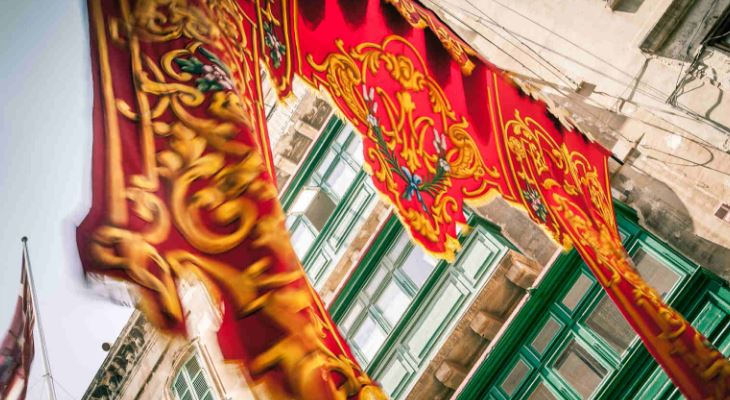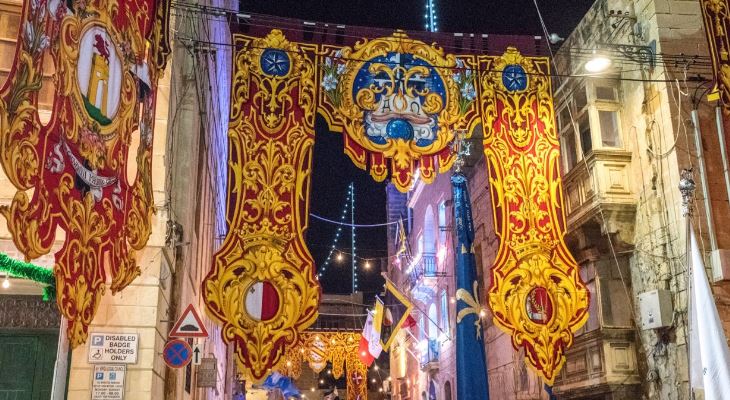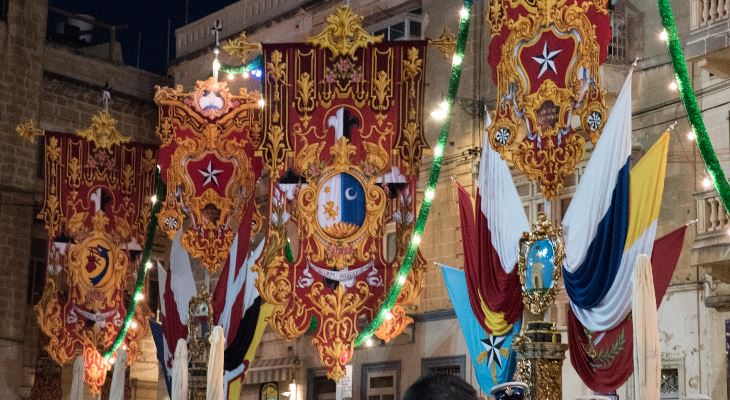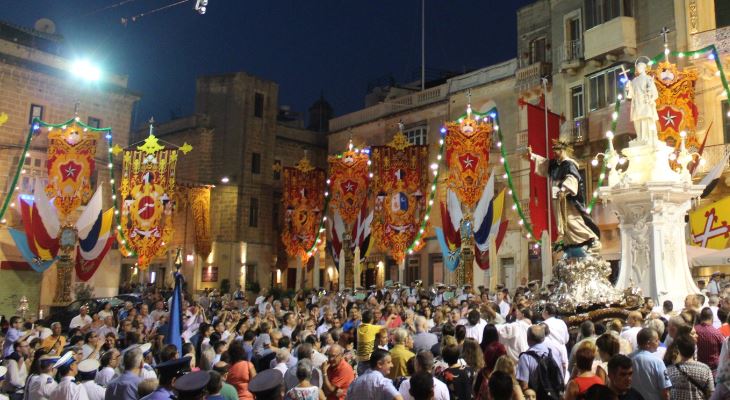Street decorations are the most iconic feature of Maltese towns in summer and nowhere more so than in the birthplace of festa banners, Vittoriosa.

Gregory Iron / viewingmalta.com
Every summer, towns and villages across the Maltese Islands don their best party dress in honour of their patron saint. Colourful flags, banners, pavilions, statues on columns, lights and flagpoles cover every inch of the towns’ streets in a cheerful, opulent and proud display of allegiance to the festa.
Street decorations as we know them today have changed little from their introduction in the early 1930s, and it was the feast of St Dominic in Vittoriosa (Birgu) that launched the tradition of matching sets of pavaljuni and bandalori, which has now been adopted across Malta and Gozo.

courtesy of Luke Scicluna
Before the advent of pavaljuni, streets used to be decorated with oil lamps hung decoratively from steel frames. Valletta feasts featured paper decorations hung on wooden structures which changed every year. Some towns were also starting to experiment with textile banners.
However, Vittoriosa decided to up the ante, and in 1934 introduced the first ever matching set of textile hand-painted pavaljuni across an entire street for the feast of St Dominic. These decorations were hung up in Triq il-Mina l-Kbira. The residents celebrating Vittoriosa’s other festa, that dedicated to St Lawrence, liked the idea for textile decorations, and copied it from the St Dominic festa supporters. Soon, the new trend spread across the island, and today it has become the mainstay of all festa decorations.

Jonathan Paris
Interestingly, little has changed in the actual format of the pavilions and banners with their Baroque hand-painted decorations, other than the fact that the designs have become far more elaborate and complicated today. The tradition has spawned a new artform, and there are artists and designers who specialise in creating these festa decorations and in a special form of shading that gives them a three-dimensional effect.
Paul Farrugia looks after the administration for the feast of St Dominic in Vittoriosa, and has been involved in the organisation of the festa quite literally all his life. He explains how these street decorations are produced by a small team of exceptionally dedicated volunteers who give up every minute of their spare time and even take vacation leave to work on the banners.
“There are a number of specialist designers who are renowned in their field for producing designs for festa pavaljuni including Silvio Pace who, in my opinion, is the best, the artist Manuel Farrugia and the Camilleri Cauchi family who are also famous for their festa statues,” explains Paul.

Jonathan Paris
“Previously these banners were made out of wool or cotton. Wool is the best for such banners, but it involved a very long work process. Cotton fades in time, so these days we use crimplene which is better suited and lasts longer,” he says.
Paul points out that the banners are all handmade and require plenty of room to make. “It's not easy producing these banners. You need a lot of space. It is all done by hand - from tracing the design onto the material to shading and sewing, it is all manual work. We have a four metre long glass table on which we lay the material and then trace the design onto it.”
He also added that there are professionals who specialise in the shading technique required to give the designs that iconic 3D effect.
“We have Ronald Attard and his partner Rita Chetcuti who do all the sewing of the drapes and banners for us. Ronald starts working on next year’s banners from the day after the festa. He sometimes comes in at 5:30am to do some sewing before heading off to his job as a boat rigger at the waterfront, and then returns to the warehouse to continue working on the pavaljuni till late in the evening. The passionate dedication is immense,” points out Paul.

Luke Scicluna
He adds that during the year there is always a team of about five or six people working on new banners or altering old ones. This team grows to over 10 people in summer in the run up to the festa.
A set of pavaljuni is changed every 10 years, but every year something new is introduced. Ahead of this year's feast, which will be celebrated on August 26th, the St Dominic festa organisers are currently working with some prominent designers on a new set of pavaljuni. The banners always feature the traditional baroque motif but include symbols that are specific to the parish. In the case of St Dominic in Vittoriosa, the banners feature the star of St Dominic, the black and white colours, the cross, the palm and the lily, as well as the coat of arms of four Dominican popes. Each banner costs between €250 and €300, but only because all the manual labour is done for free.
And what of that first set of pavaljuni that kickstarted the tradition? Paul assures me that they still exist and are stored in their warehouse but are in a delicate state and would require restoration. However, he hopes that some will eventually be displayed in the Inquisitor’s Palace in future.